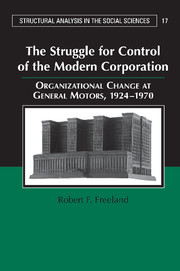 The Struggle for Control of the Modern Corporation
The Struggle for Control of the Modern Corporation Book contents
- Frontmatter
- Contents
- List of Figures and Tables
- Acknowledgments
- 1 The Modern Corporation and the Problem of Order
- 2 Creating Corporate Order: Conflicting Versions of Decentralization at GM, 1921–1933
- 3 Administrative Centralization of the M-form, 1934–1941
- 4 Participative Decentralization Redefined: Mobilizing for War Production, 1941–1945
- 5 The Split between Finance and Operations: Postwar Problems and Organization Structure, 1945–1948
- 6 Consent as an Organizational Weapon: Coalition Politics and the Destruction of Cooperation, 1948–1958
- 7 Consent Destroyed: The Decline and Fall of General Motors, 1958–1980
- 8 Conclusion
- Appendix: General Motors' Financial Performance, 1921–1987
- References
- Index
8 - Conclusion
Published online by Cambridge University Press: 05 August 2011
- Frontmatter
- Contents
- List of Figures and Tables
- Acknowledgments
- 1 The Modern Corporation and the Problem of Order
- 2 Creating Corporate Order: Conflicting Versions of Decentralization at GM, 1921–1933
- 3 Administrative Centralization of the M-form, 1934–1941
- 4 Participative Decentralization Redefined: Mobilizing for War Production, 1941–1945
- 5 The Split between Finance and Operations: Postwar Problems and Organization Structure, 1945–1948
- 6 Consent as an Organizational Weapon: Coalition Politics and the Destruction of Cooperation, 1948–1958
- 7 Consent Destroyed: The Decline and Fall of General Motors, 1958–1980
- 8 Conclusion
- Appendix: General Motors' Financial Performance, 1921–1987
- References
- Index
Summary
The General Motors case raises important questions concerning the governance of the modern corporation. Clearly, the modifications to the M-form that were in place through most of GM's history did not arise out of ignorance or error, nor did they necessarily lead to suboptimal performance. Instead, such changes were introduced as a way of creating and maintaining cooperation and order within the firm. This chapter examines the implications of the GM case for organizational analysis and the theory of the firm. I begin by addressing the changing role of owners in the modern corporation. I argue that the M-form was originally created as a means of ensuring continuing owner control in the face of the ongoing growth and differentiation between the functions of ownership and management. Yet its efficacy as an instrument of owner control was predicated on assumptions that became increasingly problematic over time. Using the Du Pont–GM relationship as a starting point, I seek to understand the conditions under which shareholders can exert effective control over corporate governance. In the second half of the chapter I turn to the relation between general office and divisions in the M-form, contrasting efficiency accounts with an approach emphasizing the role of consent in corporate governance. I argue that these two types of explanations invoke very different understandings of cooperative action that raise important theoretical and practical questions concerning the relationships among consent, information, order, and efficiency in corporate governance.
- Type
- Chapter
- Information
- The Struggle for Control of the Modern CorporationOrganizational Change at General Motors, 1924–1970, pp. 295 - 323Publisher: Cambridge University PressPrint publication year: 2000
